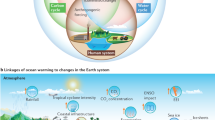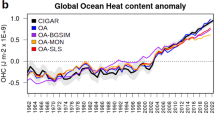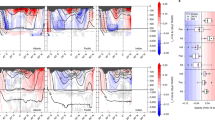Abstract
Formal detection and attribution studies have used observations and climate models to identify an anthropogenic warming signature in the upper (0–700 m) ocean1,2,3,4. Recently, as a result of the so-called surface warming hiatus, there has been considerable interest in global ocean heat content (OHC) changes in the deeper ocean, including natural and anthropogenically forced changes identified in observational5,6,7, modelling8,9 and data re-analysis10,11 studies. Here, we examine OHC changes in the context of the Earth’s global energy budget since early in the industrial era (circa 1865–2015) for a range of depths. We rely on OHC change estimates from a diverse collection of measurement systems including data from the nineteenth-century Challenger expedition12, a multi-decadal record of ship-based in situ mostly upper-ocean measurements, the more recent near-global Argo floats profiling to intermediate (2,000 m) depths13, and full-depth repeated transoceanic sections5. We show that the multi-model mean constructed from the current generation of historically forced climate models is consistent with the OHC changes from this diverse collection of observational systems. Our model-based analysis suggests that nearly half of the industrial-era increases in global OHC have occurred in recent decades, with over a third of the accumulated heat occurring below 700 m and steadily rising.
This is a preview of subscription content, access via your institution
Access options
Subscribe to this journal
Receive 12 print issues and online access
$209.00 per year
only $17.42 per issue
Buy this article
- Purchase on Springer Link
- Instant access to full article PDF
Prices may be subject to local taxes which are calculated during checkout




Similar content being viewed by others
References
Barnett, T. P. et al. Penetration of human-induced warming into the world’s oceans. Science 309, 284–287 (2005).
Palmer, M. D., Good, S. A., Haines, K., Rayner, N. A. & Stott, P. A. A new perspective on warming of the global oceans. Geophys. Res. Lett. 36, L20709 (2009).
Gleckler, P. J. et al. Human-induced global ocean warming on multidecadal timescales. Nature Clim. Change 2, 524–529 (2012).
Pierce, D. W., Gleckler, P. J., Barnett, T. P., Santer, B. D. & Durack, P. J. The fingerprint of human-induced changes in the ocean’s salinity and temperature fields. Geophys. Res. Lett. 39, L21704 (2012).
Purkey, S. G. & Johnson, G. C. Warming of global abyssal and deep Southern Ocean waters between the 1990s and 2000s: contributions to global heat and sea level rise budgets. J. Clim. 23, 6336–6351 (2010).
Loeb, N. G. et al. Observed changes in top-of-the-atmosphere radiation and upper-ocean heating consistent within uncertainty. Nature Geosci. 5, 110–113 (2012).
Llovel, W., Willis, J. K., Landerer, F. W. & Fukumori, I. Nature Clim. Change 4, 1031–1035 (2014).
Meehl, G. A., Arblaster, J. M., Fasullo, J. T., Hu, A. X. & Trenberth, K. E. Model-based evidence of deep-ocean heat uptake during surface-temperature hiatus periods. Nature Clim. Change 1, 360–364 (2011).
Palmer, M. D. & McNeall, D. J. Internal variability of Earth’s energy budget simulated by CMIP5 climate models. Environ. Res. Lett. 9, 034016 (2014).
Balmaseda, M. A., Trenberth, K. E. & Källén, E. Distinctive climate signals in reanalysis of global ocean heat content. Geophys. Res. Lett. 40, 1754–1759 (2013).
Wunsch, C. & Heimbach, P. Bidecadal thermal changes in the Abyssal Ocean. J. Phys. Oceanogr. 44, 2013–2030 (2014).
Roemmich, D., Gould, W. J. & Gilson, J. 135 years of global ocean warming between the Challenger expedition and the Argo Programme. Nature Clim. Change 2, 425–428 (2012).
Roemmich, D. et al. Unabated planetary warming and its ocean structure since 2006. Nature Clim. Change 5, 240–245 (2015).
Levitus, S., Antonov, J. & Boyer, T. Warming of the world ocean, 1955–2003. Geophys. Res. Lett. 32, L02604 (2005).
Rhein, M. et al. in Climate Change 2013: The Physical Science Basis (eds Stocker, T. F. et al.) Ch. 3, 255–315 (IPCC, Cambridge Univ. Press, 2013).
Domingues, C. M. et al. Improved estimates of upper-ocean warming and multi-decadal sea-level rise. Nature 453, 1090–1093 (2008).
Sokolov, A. P., Forest, C. E. & Stone, P. H. Sensitivity of climate change projections to uncertainties in the estimates of observed changes in deep-ocean heat content. Clim. Dynam. 34, 735–745 (2010).
Church, J. A. et al. in Climate Change 2013: The Physical Science Basis (eds Stocker, T. F. et al.) Ch. 13, 1137–1206 (IPCC, Cambridge Univ. Press, 2013).
Gregory, J. M. et al. Climate models without preindustrial volcanic forcing underestimate historical ocean thermal expansion. Geophys. Res. Lett. 40, 1600–1604 (2013).
Ishii, M. & Kimoto, M. Re-evaluation of historical ocean heat content variations with time-varying XBT and MBT depth bias corrections. J. Oceanogr. 65, 287–299 (2009).
Levitus, S. et al. World ocean heat content and thermosteric sea level change (0–2000 m), 1955–2010. Geophys. Res. Lett. 39, L10603 (2012).
Lyman, J. M. & Johnson, G. C. Estimating global ocean heat content changes in the upper 1800 m since 1950 and the influence of climatology choice. J. Clim. 27, 1945–1957 (2014).
Abraham, J. P. et al. A review of global ocean temperature observations: implications for ocean heat content estimates and climate change. Rev. Geophys. 51, 450–483 (2013).
Durack, P. J., Gleckler, P. J., Landerer, F. W. & Taylor, K. E. Quantifying underestimates of long-term upper-ocean warming. Nature Clim. Change 4, 999–1005 (2014).
Santer, B. D. et al. Volcanic contribution to decadal changes in tropospheric temperature. Nature Geosci. 7, 185–189 (2014).
Cheng, L. & Zhu, J. Artifacts in variations of ocean heat content induced by the observation system changes. Geophys. Res. Lett. 41, 7276–7283 (2014).
Zhang, R. et al. Have aerosols caused the observed Atlantic multidecadal variability? J. Atmos. Sci. 70, 1135–1144 (2013).
Kuhlbrodt, T. & Gregory, J. M. Ocean heat uptake and its consequences for the magnitude of sea level rise and climate change. Geophys. Res. Lett. 39, L18608 (2012).
Gregory, J., Banks, H., Stott, P., Lowe, J. & Palmer, M. Simulated and observed decadal variability in ocean heat content. Geophys. Res. Lett. 31, L15312 (2004).
Pierce, D. W. et al. Anthropogenic warming of the oceans: observations and model results. J. Clim. 19, 1873–1900 (2006).
AchutaRao, K. et al. Variability of ocean heat uptake: reconciling observations and models. J. Geophys. Res. 111, C05019 (2006).
Church, J. A. et al. Revisiting the Earth’s sea-level and energy budgets from 1961 to 2008. Geophys. Res. Lett. 38, L18601 (2011).
Flato, G. et al. in Climate Change 2013: The Physical Science Basis (eds Stocker, T. F. et al.) Ch. 9, 741–866 (IPCC, Cambridge Univ. Press, 2013).
2015: IPRC Products Based on Argo Data (International Pacific Research Center, 2015); http://apdrc.soest.hawaii.edu/projects/argo.
Hosoda, S., Ohira, T. & Nakamura, T. A monthly mean dataset of global oceanic temperature and salinity derived from Argo float observations. Vol. 8, 47–59 (JAMSTEC (Japan Agency for Marine-Earth Science and Technology), 2008); www.jamstec.go.jp/ARGO.
Taylor, K. E., Stouffer, R. J. & Meehl, G. A. An overview of CMIP5 and the experiment design. Bull. Am. Meteorol. Soc. 93, 485–498 (2012).
Ridley, D. A. et al. Total volcanic stratospheric aerosol optical depths and implications for global climate change. Geophys. Res. Lett. 41, 7763–7769 (2014).
Acknowledgements
The work of P.J.G. and P.J.D., from Lawrence Livermore National Laboratory, is a contribution to the US Department of Energy, Office of Science, Climate and Environmental Sciences Division, Regional and Global Climate Modeling Program under contract DE-AC52-07NA27344. C.E.F. was partially supported by the US Department of Energy, Office of Science, Office of Biological and Environmental Research, grants DE-SC0004956 (as a member of the International Detection and Attribution Working Group (IDAG)) and DEFG02-94ER61937 and by the National Science Foundation through the Network for Sustainable Climate Risk Management (SCRiM) under NSF cooperative agreement GEO-1240507. G.C.J. is supported by NOAA Research and the NOAA Ocean Climate Observations Program. We thank K. Taylor, B. Santer and J. Gregory for their helpful suggestions concerning our analysis. We acknowledge the sources of observed data used in this study: C. M. Domingues, M. Ishii and M. Kimoto, S. Levitus and T. Boyer, S. Purkey and G. Johnson, D. Roemmich and J. Gilson, S. Hosoda, T. Ohira and T. Nakamura and the International Pacific Research Center. We thank the climate modelling groups (listed in Supplementary Table 1) for producing and making available their model output.
Author information
Authors and Affiliations
Contributions
P.J.G., R.J.S. and C.E.F. conceived the experimental design, P.J.G. and P.J.D. performed the analysis, G.C.J. provided data and expertise on deep ocean measurements, and P.J.G. wrote the paper with substantial input from all authors.
Corresponding author
Ethics declarations
Competing interests
The authors declare no competing financial interests.
Supplementary information
Supplementary Information
Supplementary Information (PDF 902 kb)
Rights and permissions
About this article
Cite this article
Gleckler, P., Durack, P., Stouffer, R. et al. Industrial-era global ocean heat uptake doubles in recent decades. Nature Clim Change 6, 394–398 (2016). https://doi.org/10.1038/nclimate2915
Received:
Accepted:
Published:
Issue Date:
DOI: https://doi.org/10.1038/nclimate2915
This article is cited by
-
Growth of ocean thermal energy conversion resources under greenhouse warming regulated by oceanic eddies
Nature Communications (2022)
-
Past and future ocean warming
Nature Reviews Earth & Environment (2022)
-
Volcanic effects on climate: recent advances and future avenues
Bulletin of Volcanology (2022)
-
Living on the edge: environmental variability of a shallow late Holocene cold-water coral mound
Coral Reefs (2022)
-
Projected ocean warming constrained by the ocean observational record
Nature Climate Change (2021)



